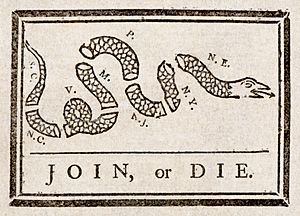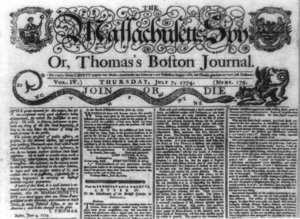Join, or Die facts for kids

Join, or Die. is a famous political cartoon created by Benjamin Franklin. It was first printed in his newspaper, The Pennsylvania Gazette, on May 9, 1754. This drawing is the oldest known picture made by an American colonist that showed the idea of the colonies joining together.
The cartoon is a woodcut (a type of print) that shows a snake cut into eight pieces. Each piece has the first letter of one of the American colonies or regions. For example, all of New England was shown as one piece. Delaware was part of Pennsylvania, so it wasn't separate. Georgia was not included at all. So, the snake has eight parts, not 13. The cartoon focused on colonies that felt they shared an identity as Americans. It appeared with Franklin's article about how divided the colonies were. The cartoon helped him show why it was important for the colonies to unite. Later, it became a symbol of freedom during the American Revolutionary War.
Contents
Why the Cartoon Was Made: The French and Indian War
The French and Indian War was a big conflict that was part of the Seven Years' War. In this war, Great Britain and the Thirteen Colonies fought against France and their allies. Many American colonists wanted to control the lands west of the Appalachian Mountains. They hoped to settle there or make money from new settlements.
When the war started, the American colonists were not sure if they should fight the French. The "Join, or Die" cartoon quickly became a symbol. It showed that the colonies needed to work together against the French and their Native American allies. Many Americans did not want to fight. But they knew that if the French colonies were not stopped, they would always be a danger to the Thirteen Colonies.
Benjamin Franklin was a propagandist. He understood how political cartoons could make people feel strongly about an idea. Franklin had suggested a plan called the Albany Plan. His cartoon showed that such a union was needed. Without it, each colony might be captured by the French one by one. Franklin wrote that the French felt confident because the British Colonies were "disunited." He said it was hard for many different governments to agree on ways to protect themselves. Meanwhile, their enemies had one leader and one plan.
A New Meaning: The American Revolution
Franklin's political cartoon took on a new meaning before the American Revolution. This happened especially around 1765–1766, during the Stamp Act Congress. American colonists were protesting against the rule of the Crown (the British government). They used the cartoon in a newspaper called the Constitutional Courant. It helped convince other colonists to stand up for their rights.
The Patriots, who wanted independence, saw the image as a sign of unity and wisdom. However, the Loyalists, who supported Britain, saw the snake as a sign of trickery. Franklin himself did not want his cartoon used this way at first. He preferred a more peaceful approach. In 1766, he made a new cartoon. It warned Britain about losing its American colonies. It showed a female figure (Britannia) with her arms and legs cut off. But because of Franklin's first cartoon, the Courant was seen as a very radical newspaper in England.
The cartoon's use changed between 1754 and 1765. In 1754, Franklin wanted the colonies to unite for defense against France. But in 1765, American colonists used it to push for unity against unfair laws from Britain. Also, during this time, the phrase "join, or die" sometimes changed to "unite, or die." This happened in states like New York and Pennsylvania.
After the cartoon was used during the Stamp Act Congress, other versions were printed. They appeared in New York, Massachusetts, and later in Virginia and South Carolina. In some places, like New York, the cartoon was printed every week for over a year. On July 7, 1774, Paul Revere changed the cartoon. He put it on the masthead (the title area) of the Massachusetts Spy newspaper.
Legacy of the Cartoon
The "Join, or Die" cartoon has been printed and redrawn many times throughout American history. Different versions have had different words or labels on the snake segments. This depended on the political groups they were trying to reach. During the American Revolutionary War, the image became a strong symbol of unity among the American colonists. It showed their resistance to the British Parliament and the King.
The cartoon was even used again during the American Civil War. Both sides, the Union and the Confederacy, used it to support their different ideas about the government.
- The Philadelphia Union soccer team uses the Latin translation of "Join, or Die" (Jungite aut Perite) as its official motto. A snake is also part of their logo.
- A flag with this cartoon was shown in the opening of the 2008 TV show John Adams. The first part of the show was even named "Join or Die."
- Craig Ferguson, a former TV host, has this cartoon tattooed on his arm. He got it to celebrate becoming an American citizen. He also named his show on the History Channel, Join or Die with Craig Ferguson, after the cartoon.
- "Join Or Die" is the name of a special edition of the video game Assassin's Creed III. This game is set during the American Revolutionary War.
- In the TV show Falling Skies, a character named Tom Mason tells another character, "Join, or Die!" Tom Mason was a history professor who taught about the American Revolution.
See also
 In Spanish: Join, or Die para niños
In Spanish: Join, or Die para niños


